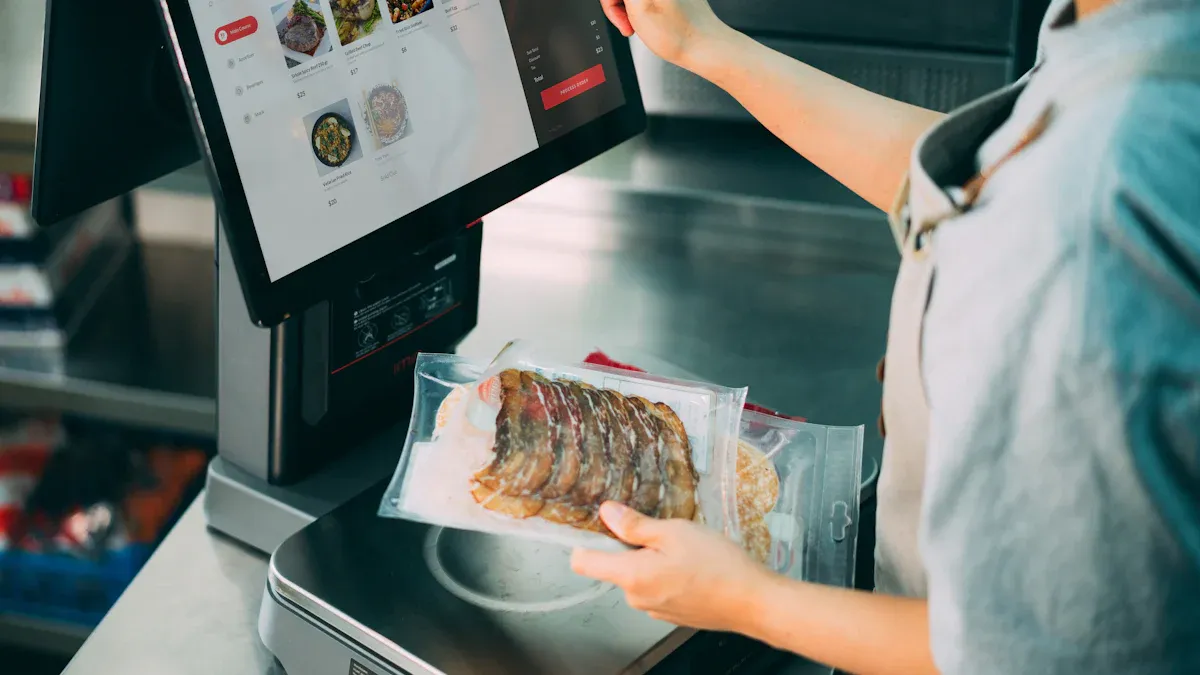Is Your Store Meeting the Latest AI Checkout Speed Standards

Checkout speed significantly impacts customer satisfaction during shopping. Shoppers prefer to navigate through the store quickly and make purchases without delays.
77% of shoppers appreciate self-checkout because it is faster.
Even a brief wait can diminish your sales and erode trust. Here are some recent facts:
Evidence Description | Impact on Sales Conversion Rates |
|---|---|
Every 100 milliseconds of ai checkout latency could cost 1% in sales | Slow responses can lead to substantial declines in sales |
Brands using Alhena AI report a 3× lift in conversion rates | Sales conversion rates increase with Alhena AI |
A leading DTC skincare brand experienced a 14% rise in checkout completion after optimizing ai checkout latency | Faster responses enable more customers to complete their purchases |
Is your store adhering to the latest ai checkout speed standards? You can discover strategies to enhance performance and keep shoppers satisfied.
Key Takeaways
Fast checkout speeds make customers happy. Try to keep checkout latency at 5 seconds or less. This helps shoppers feel good about your store.
Every 100 milliseconds of delay can lose you 1% in sales. Lowering latency can help you make more money.
Check your AI checkout performance often. Use key metrics like Time to First Token and Total Response Time. These can help you find slow areas.
Make your AI models better and use edge computing. This can cut down network delays. Faster processing gives customers a better experience.
Teach your staff how to use new systems. This helps everything run smoothly. A smart team keeps checkout fast.
Industry Standards
Current Performance
It is important to see how top stores handle ai checkout latency. Amazon and Shopify are leaders with their own rules. Amazon wants checkout latency to be 5 seconds or less. Shopify has a similar rule for offer latency but allows up to 20 seconds for checkout. These numbers show what shoppers want when they buy online.
Company | Order Reliability | Offer Latency | Checkout Latency | MF |
|---|---|---|---|---|
Amazon | 99% | 5 s | 5 s | 1% |
Shopify | 96% | 5 s | 20 s | 5% |
Cashierless stores try to be even faster. They aim for response times as quick as 33 milliseconds. AI Commerce Cloud wants latency under 100 milliseconds. These goals show that speed is very important. If you add AI features like product recommendations or chat, your system works harder. Each new feature can slow down checkout if you do not make your system better.
Fast ai checkout latency keeps customers happy and helps them finish buying.
Common Challenges
There are many problems when trying to meet these standards. Technical problems can slow your system and upset shoppers. Here are some common problems:
Challenge | Description |
|---|---|
Occlusion and Positioning | Items might be hidden or placed oddly, so they are hard to scan. |
Variable Lighting Conditions | Bad lighting can confuse your system and make checkout slower. |
Fine-Grained Recognition | Products that look the same need careful scanning to avoid mistakes. |
Product Enrollment | Adding new products takes time and work. |
Product Catalog Size | Big catalogs can slow down finding items and increase ai checkout latency. |
Number of Stores | Each store needs special changes, which takes time and effort. |
Solution Costs | Hardware and setup can cost a lot, so you have fewer choices. |
Systems Integration | Adding new AI tools to old systems can be hard and take a long time. |
You need to fix these problems to meet industry standards. If you solve them, you can make ai checkout latency lower and help your store do better.
Why Speed Matters

Customer Experience
You want your customers to feel happy and valued every time they shop. Fast checkout makes this possible. When you use AI checkout systems, you cut down wait times. This quick service helps shoppers enjoy their visit and encourages them to return. Studies show that when stores use AI for checkout, customer satisfaction scores can rise by up to 30%. Shoppers notice the difference. They remember stores that respect their time.
A smooth and speedy checkout can turn a regular shopper into a loyal fan.
Sales Impact
Speed at checkout does more than make people smile. It also helps your sales. Even a small delay can cost you money. For example, a 100-millisecond delay in checkout can lower your sales by 1%. Fast responses boost customer satisfaction and help more shoppers finish their purchases. Slow responses break trust and cause frustration. You want every shopper to complete their order. Quick checkout helps you reach this goal.
Here is how latency affects your sales:
Impact of Latency on Sales | Description |
|---|---|
100 milliseconds delay | Can cost 1% in sales |
Fast responses | Boost customer satisfaction and conversions |
Slow responses | Break trust and increase frustration |
Operational Costs
You also save money when you improve ai checkout latency. Faster systems need less staff time to solve problems. You spend less on fixing errors or handling complaints. When your checkout runs smoothly, you can serve more customers with the same resources. This efficiency lowers your costs and helps your business grow.
Quick checkout is not just about speed. It is about building trust, increasing sales, and keeping your costs low.
AI Checkout Latency Benchmarks

Defining Latency
You need to know what latency means before you can fix it. In AI checkout systems, latency is how long your system takes to answer after a customer does something. This covers every step from when a shopper scans an item or pays to when the system shows what happened.
Latency is the time from when someone does something to when the system answers. You see this when a customer scans a product and waits for the system to notice it.
It looks at inference latency, which is how fast your AI model works on a request and gives an answer.
Latency also includes waiting from getting data ready, doing math, moving data, and finishing up.
You should watch how quickly your system handles inputs and gives results when people use it in real life.
Lower latency makes checkout easier and quicker for your customers.
Key Metrics
There are a few important ways to measure ai checkout latency in your store. These help you find where things slow down and how to make shopping better for your customers.
Metric | Description |
|---|---|
Time to First Token (TTFT) | Time taken to generate the first token of output |
Time Per Output Token (TPOT) | Average time taken for each subsequent token |
Total Response Time | Overall time from query submission to response |
Time to First Token (TTFT) shows how fast your system starts to answer after a customer does something.
Time Per Output Token (TPOT) checks how quickly each step happens as your system finishes checkout.
Total Response Time is the whole time from when a customer asks for something to when they get an answer.
You should also think about how extra AI features change these numbers. For example, AI chatbots can answer lots of questions at once, so shoppers do not have to wait long and get help fast. Personalized product suggestions help customers find things quicker and can make orders bigger. These features can make customers happier and want to come back, but they might also slow down ai checkout latency if not set up well.
Watching these important numbers helps you find slow spots and fix them so checkout stays fast and works well.
Measuring AI Checkout Latency
Tools and Methods
You need the right tools to check how fast your AI checkout is. First, find out where your system gets slow. This helps you know what to fix first. Use profiling tools and Application Performance Monitoring (APM) solutions. These tools show you the whole process from when a customer scans an item to when the system answers.
Break your AI pipeline into small parts. Look at model inference, API calls, and data processing. This helps you see which part is slowest.
Write down important numbers like input size and model load times. These details help you understand how your system works.
Watch key numbers like response time and throughput. These numbers show how fast your system answers and how many requests it can handle.
Check your system often. These checks help you keep your system fast and make sure customers get quick answers.
Tip: Knowing these numbers helps you make your app work better and keeps your customers happy.
Avoiding Pitfalls
You might run into some problems when checking ai checkout latency. Knowing about these problems helps you avoid mistakes and keep your system working well.
Pitfall | Description | How to Avoid |
|---|---|---|
Poor Data Quality | Bad or missing data can give wrong results and hurt customers. | Use good data rules and tools to clean and check your data. |
Integration Challenges | Old systems may not work well with new AI tools and can slow things down. | Update your systems slowly and make them easy to connect. |
Talent Shortages | Not enough skilled workers can slow down AI projects or cause mistakes. | Train your team and have people with different skills work together. |
You can keep your ai checkout latency low by watching for these problems. Good data, updated systems, and skilled teams help your store work well and keep shoppers happy.
Compare to Benchmarks
Checklist
You need a clear checklist to see if your store meets the latest AI checkout speed standards. Use this list to check your system’s performance:
⏱️ Measure your average checkout latency.
Compare your results to the industry benchmarks. Amazon and Shopify set the standard at 5 seconds or less.🛒 Test your system with real customers.
Watch how long it takes for a customer to finish checkout from start to end.📊 Check your AI features.
See if product recommendations or chatbots slow down your checkout.🔄 Review your system during busy times.
Make sure your checkout stays fast when many people shop at once.🧩 Look at your integration.
Check if your AI tools work well with your other systems.📝 Track your key metrics.
Record Time to First Token (TTFT), Time Per Output Token (TPOT), and Total Response Time.
Tip: Use this checklist every month. Regular checks help you spot problems early and keep your store running smoothly.
Performance Review
Now, compare your results to the benchmarks. Use a simple table to see where you stand:
Metric | Your Store | Industry Standard | Pass/Fail |
|---|---|---|---|
Average Latency | ≤ 5 seconds | ||
Peak Time Latency | ≤ 5 seconds | ||
TTFT | ≤ 100 ms | ||
TPOT | ≤ 33 ms | ||
Total Response Time | ≤ 5 seconds |
Fill in your numbers. If you see “Fail” in any row, you need to improve that area. Fast checkout helps you keep customers happy and boost sales. Slow checkout means you risk losing shoppers.
Note: Meeting or beating these benchmarks gives your store a strong advantage. You show customers that you value their time.
Improve Checkout Speed
Optimize AI Models
You can make your checkout faster by making your AI models better. Many stores use special tricks to cut down wait times.
Model Quantization makes your AI model smaller, so it works faster and uses less memory.
Post-Training Quantization (PTQ) helps you lower latency after training your model. You get a smaller model that is still almost as accurate.
Quantization-Aware Training (QAT) lets you train your model to handle quantization, so it usually stays accurate.
Model Pruning takes out parts of the model you do not need. This makes your system run faster and easier.
Tip: Try these ways to make checkout faster and keep customers happy.
Reduce Network Delays
You can make checkout faster by fixing your network setup. Edge-to-cloud computing lets you process data close to your store. This means your system does not send information far away. Local processing does simple jobs right away, so customers get answers faster. You see fewer delays, and checkout feels smooth.
Real-Time Processing
You need real-time processing to keep checkout fast. New technology helps you do this.
Technology | Description | Typical Latency Reduction |
|---|---|---|
Edge AI | Lets you process data quickly on local devices and servers. | 1-5 milliseconds vs. 100-500 milliseconds |
GPU Upgrades | Fast GPUs help with quick, local computing for real-time analytics. | Big drop in processing time. |
Edge AI devices can process data in just 1-5 milliseconds. This is much faster than cloud systems, which can take 100-500 milliseconds. You can also use autonomous checkout and smart weighing tools for instant results.
Staff Training
Your team is important for checkout speed. Train your staff to use new systems and spot slowdowns. Teach them how to help customers with self-checkout kiosks and biometric payments. When your team knows how to use smart devices and AI security, you avoid slow lines and keep things moving.
A trained team makes checkout faster and gives everyone a better shopping trip.
You help your store do well by meeting AI checkout speed standards. Checking and updating your system often keeps it fast and working right. Many shoppers like self-checkout because it is quick and simple. You can see the good things in the table below:
Benefit | Description |
|---|---|
Enhanced Customer Experience | Easier shopping makes people happier and want to come back. |
Increased Operational Efficiency | Faster steps mean less waiting and better service. |
Cost Reduction | Making things better saves your store money. |
43% of shoppers pick self-checkout because it is efficient.
Keep checking your system and making it better. This helps you give shoppers what they want and stay ahead of other stores.
FAQ
What is the ideal AI checkout latency for my store?
Try to keep checkout latency at 5 seconds or less. Big stores like Amazon use this rule. If you get times under 100 milliseconds, your store will do even better.
How can I measure my store’s AI checkout speed?
Use tools like Application Performance Monitoring to watch response times. Look at each step in your checkout process. Write down important numbers like Time to First Token and Total Response Time.
Do extra AI features slow down checkout?
Yes, adding things like chatbots or recommendations can make latency higher. You should make your system work better and check how it performs. Test new features before letting all customers use them.
What are quick ways to improve checkout speed?
Make your AI models work faster.
Use edge computing for quicker answers.
Teach your staff how to use new systems.
Tip: Check your system’s speed often to keep it working well and fast.
See Also
Upcoming Changes to Walmart Self-Checkout in 2025
Boosting Efficiency and Experience with Cloudpick Checkout Systems
The Progression of Self-Checkout Technology Over Time
Walgreens Self-Checkout: Balancing Convenience and Retail Hurdles
Introducing Cashierless Shopping Solutions with Cloudpick Technology
